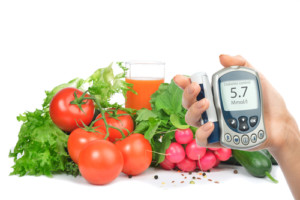Diabetic Diets
 What causes high blood sugar levels in Type 2 Diabetes?
What causes high blood sugar levels in Type 2 Diabetes?
High blood sugar levels are caused by insulin resistance, and insulin resistance is caused mainly by a diet that is too high in carbohydrates and a lack of certain nutrients.
Carbohydrates are simply long chains of sugar molecules (glucose) hooked end-to-end. When you eat carbohydrates your normal digestive process breaks up these chains into the individual sugar molecules, and they pass right through your intestinal wall into your bloodstream and load up your bloodstream with sugar.
If this happened every once in a while it would not be a problem. But as diets today are so high in carbohydrates, you have had a constant high level of sugar pouring into your bloodstream year after year! This requires your body to continuously produce high levels of insulin to keep that blood sugar level down. (Insulin’s job is to push sugar out of the bloodstream into the cells where it is used for energy.)
Eventually, the cells in your body became insensitive to the effects of insulin (insulin resistance). To handle this problem of insulin resistance your body began to produce even higher levels of insulin. This continued until your pancreas reached the maximum amount of insulin it could produce, and when the insulin resistance increased again, your blood sugar began to rise out of control. The result is type 2 diabetes! (Type 2 diabetes is actually an extreme case of insulin resistance.)
What can you do? A Healthy Diabetic Diet
If you have not already done so, you need to eliminate ALL the starchy carbohydrates from your diet and stop loading up your body with sugar. Even small amounts of these starchy carbohydrates will prevent your sugar levels from coming down.
This action will give your body a “breather” and the insulin will be able to do its job of pushing the sugar out of your bloodstream and into the cells, your blood sugar level will drop naturally and the high level of insulin in your body will drop along with it.
You need to keep the carbohydrates at 20-30 a day.
NOTE: do not overdo the protein. You want to eat 3-4 oz. of protein. Eating a big 10-12 oz. steak will increase insulin 200X. Stick to 3-4 oz. of protein (as below) and lots of green.
Diabetic Diets basics
What not to eat, and what to eat
You cannot eat:
Foods high in carbohydrates such as:
- Potatoes and potato produce (including yams and sweet potatoes).
- No winter squash (hardshell squash)
- Any products made from grains such as wheat, rye, rice, oats & corn.
- Any type of bread, pasta, chips or cereals.
- Any type of hard beans (except green beans) – navy beans, pinto beans, black-eyed peas, kidney beans, black beans, soybeans, etc. This includes peas and peanuts. No tomatoes – they are a fruit.
- No doughnuts, cakes, pies, pastries, cookies, and chocolate.
- No milk or soft cheeses.
- Most fruits and no fruit juices (see below for fruits you can eat)
- You also need to eliminate fruit or fruit juice because of its high sugar content except as noted below.
What foods you can eat:
- Animal protein Any kind of meat including beef, pork, lamb, turkey, chicken. Any kind of fish, seafood or shellfish. Not more than 3-4 oz. per serving. If you eat more at one sitting, the body will turn the excess protein into sugar. A lot of diabetic diets don’t tell you this.
- You can have eggs. You can have tofu.
- Cheese – cottage cheese, cream cheese, parmesan, feta, ricotta mozzarella, muenster, cheddar, sour cream, etc. (no milk)
- If you feel you must have some fruit you can have ¼ cup of berries a day (blueberries, raspberries, strawberries, etc.) or ½ of a very small apple, but only in moderate amounts.
- You can have honeydew melon or cantaloupe and Avocados but only moderate amounts.
- Vegetables: Lots and Lots of Vegetables. Green is good. Green leafy vegetables, broccoli, green beans, cabbage, Brussels sprouts, cauliflower, celery, asparagus, any kind of greens such as spinach, beet greens, kale, Swiss chard, mustard greens, and turnip greens.
- Salad materials such as any kind of lettuce, cucumbers, bell peppers, etc.
- Carrots, beets, turnips, tomatoes, and parsnips may only be eaten in very small quantities due to their high sugar content
- Any kind of oil such as corn, olive, peanut, walnut, grapeseed, sesame seed oil, avocado oil, etc.
- Butter and Nut Butters.
- You can have nuts: sunflower seeds, almonds, Brazil nuts, walnuts, macadamia nuts. (No hazelnuts, cashews or pecans) Note: All nuts have some carbs but you can eat them in small quantities.
- And Camel Milk – Find out why it helps Diabetes It has been shown to lower blood sugar and improve insulin sensitivity in people with both type 1 and type 2 diabetes.
Diet is part of a Diabetic Program. You need Diet & Exercise and also nutritional supplements will healp.
See: Diabetes Health & Diabetic Nutition
See: Mitochondrial Dysfunction
See: Understanding the Diabetic Condition
STILL HAVE QUESTIONS? EMAIL AND GET YOUR QUESTIONS ANSWERED.
Sign up to receive the MCVitamins Newsletter!
Up-to-date info on the latest health-related news happening in the world
(available in English only)

